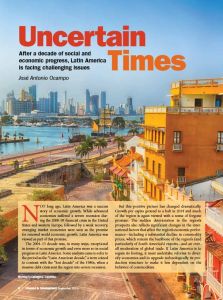Join getAbstract to access the summary!

Join getAbstract to access the summary!
José Antonio Ocampo
Uncertain Times
IMF, 2015
What's inside?
Unless countries in Latin America institute major reforms, the region’s economic future could be quite bleak.
Recommendation
Latin America saw rapid economic development between 2004 and 2013, and after the 2008 financial crisis, the region stood out as a bright spot on an otherwise dark economic horizon. Today, however, prospects are very different. Beginning in 2014, several Latin American economies stumbled as commodity prices plummeted and global trade fell off. Economist José Antonio Ocampo explains the reforms the region must undertake to regain its place on the world economic stage. His concise article provides insights into how Latin America should address slow growth. getAbstract recommends it to executives and economists interested in the region’s future.
Summary
About the Author
José Antonio Ocampo, a professor at Columbia University, has held various high-level economic posts at the United Nations and in Latin America.


















Comment on this summary